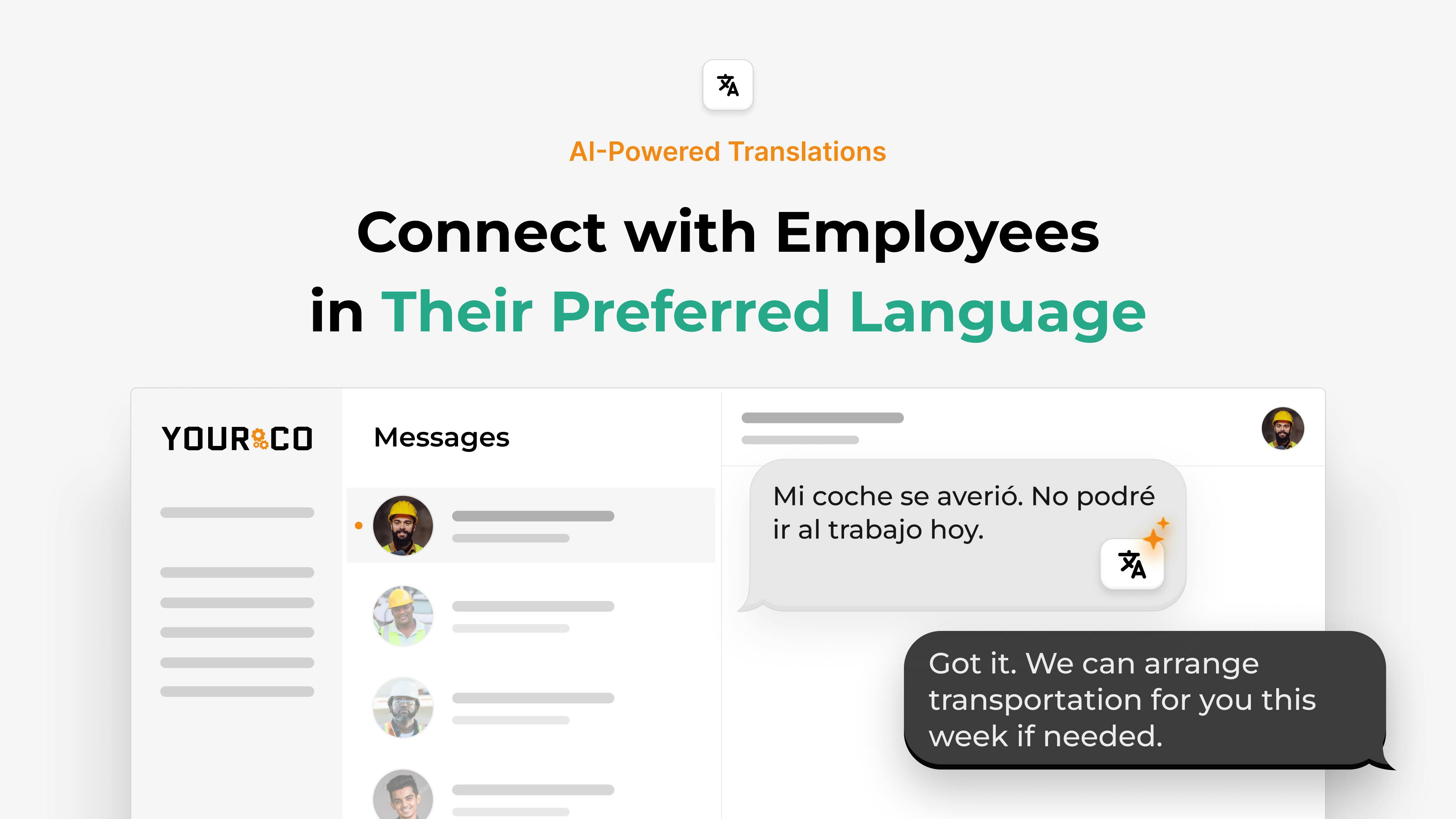SMS: The Future of Multilingual Mobile Employee Communications


In every workplace, fast and clear communication is the difference between smooth operations and missed opportunities. But in reality, too many updates never make it past a cluttered inbox, a forgotten login, or a language barrier. As companies grow more global and mobile, the cracks in traditional communication tools are starting to show.
That’s why many organizations are turning to a tool that’s been right in front of us all along: text messaging.
Simple, direct, and already in everyone’s pocket, SMS is proving to be the most reliable way to reach employees — instantly, clearly, and in their preferred language. In this guide, we’ll explore why texting outperforms email and internal platforms in today’s workforce, and how smart, multilingual SMS systems are transforming the way businesses stay connected at every level.
Why Traditional Communication Channels Fall Short
Many teams don’t sit at desks all day. Yet most workplace communication still depends on tools built for office environments. This disconnect leads to serious gaps that affect safety, productivity, and trust.
Missed Updates
Most frontline teams miss critical updates when messages live in inboxes or systems they rarely access. Most non-desk workers use their own phones on the shop floor or jobsite, not company laptops. They also rarely use the internet while on the job. Without easy access, your well-crafted email or system notification often never reaches the people who need it.
Low Adoption
Even when you roll out a workplace system, adoption stalls. Download links, usernames, and password resets create barriers, especially for workers managing multiple languages and varying comfort with technology. Printed signs or verbal translations try to fill the gap, but they become outdated quickly and leave too much room for confusion.
Uneven Access
Office staff see real-time dashboards while welders, drivers, and cleaners learn about policy changes days later, often through informal conversations with coworkers. When only part of your workforce stays in the loop, trust erodes and engagement drops.
Compliance Risk
Delayed or missed information also risks compliance fines when safety protocols or wage notices aren't delivered on time. Chasing signatures, printing new posters, or holding extra briefings wastes hours you don't have.
Disconnected Systems
When you depend on email and workplace systems alone, you're asking non-desk employees to meet you on channels designed for desk jobs. The result is slower reactions, higher error rates, and a workforce that feels left out by the very systems meant to keep everyone connected.
To truly connect with non-desk teams, communication needs to meet them where they are — on the devices they already use, in the languages they understand, without logins or downloads getting in the way.
4 Reasons Why SMS Wins for Frontline and Multilingual Teams
Text messaging delivers exactly what you need: a communication channel that works on any phone and reaches every worker, no matter what language they speak. Its universal reach, simple interface, instant delivery, and low cost make it the most reliable way to connect with teams who spend their days away from desks.
1. Ubiquity and Reach
Text messaging works on flip phones, feature phones, and smartphones, regardless of carrier or operating system. Since it runs on the cellular network, messages get through even in areas with weak or no data coverage, such as remote job sites or warehouse dead zones.
When you choose text messaging, you meet everyone where they already are. Plant managers with company laptops and line workers with prepaid flip phones get the same information at the same time.
2. Inclusivity Through Simplicity
Short text messages are easier to translate and understand than complex system screens or lengthy emails. Modern texting platforms can automatically deliver each message in a worker's preferred language, eliminating the need for interpreters on the shop floor. Workers don't need to remember logins or install updates, just open a familiar text thread with one tap.
This simplicity matters because language barriers hurt productivity and safety. Workplace accidents often stem from miscommunication, and manufacturing teams frequently include workers who primarily speak a language other than English.
By removing digital blockages, text messaging helps every employee understand safety rules, shift notes, and policy changes immediately. When comprehension improves, mistakes and injuries decrease.
3. Real-Time Delivery and Reliability
A safety alert that arrives ten minutes late might rarely help. Text messages reach phones instantly, without waiting for Wi-Fi or system permissions. During a sudden weather evacuation, you can send instructions in seconds and track confirmations as they come in. Shift swaps, overtime requests, and last-minute route changes travel just as fast, ensuring the right people show up at the right time.
Also, texts don't get buried behind unread badge counts or spam filters. Field teams feel the buzz, glance at the screen, and act. That immediacy keeps operations moving.
4. Cost-Effectiveness at Scale
Texting costs pennies per message and requires no hardware investment, since workers already bring their own phones. Some modern platforms, such as Yourco, even offer unlimited messaging regardless of the package you choose. Compare that with buying, updating, and replacing company devices or paying developers to maintain a custom system. Also, automation tools let you schedule multilingual messages, collect replies, and sync records back to your HR system with minimal staff time.
Miscommunication costs far more than any texting plan. Every unclear instruction risks rework, delays, or injury. By using a channel workers already know and trust, you save on technology overhead while avoiding the hidden expenses of missed messages.
Key Use Cases for SMS in Multilingual Mobile Communication
With SMS, you can handle the full range of daily communications:
Onboarding Process
Consider new hires who walk through your doors. Whether you’re onboarding Chinese speakers, Spanish speakers, or native English speakers, a quick welcome text in their preferred language can link to short training videos or direct them to text photos of required documents like ID or tax forms right back to the company number. The message lands instantly, so new team members start learning before they step on the floor. This reduces first-day anxiety and helps supervisors focus on other priorities.
Employee Alerts
Safety alert messages need speed and clarity. Misunderstandings contribute to workplace accidents, so a clear, multilingual alert about a chemical spill or incoming storm prevents injuries. SMS works even when Wi-Fi drops, making it reliable on busy factory floors or remote job sites where connection matters most. Workers can even text back photos and details about safety incidents directly to the company number, creating timestamped records for follow-up.
Employee Benefits Communication
HR teams rely on text to keep policies and benefits visible. A reminder that wage statements are ready or that open enrollment closes Friday reaches everyone, including workers who never check email. Two-way texting lets employees reply with questions or even allows managers to approve time-off requests with a simple "Approved" response, reducing visits to the HR office.
Shift Scheduling Made Simple
Schedules change fast in shift-based work. When someone calls out sick by texting the company number, one group text can fill an open spot and confirm the replacement. This clarity reduces overtime costs and the productivity losses that happen when language gaps create confusion.
Survey Distribution
Surveys become simple wins. Short polls sent by SMS collect feedback on training, safety culture, or cafeteria options. Workers can answer in their preferred language using built-in polling features or quick yes/no replies, so response rates climb and the data feels more authentic.
Here are sample templates that translate easily across languages:
- "Welcome aboard — open link to begin training."
- "Shift moved to 6 AM tomorrow. Reply YES to confirm."
- "Severe weather alert — move to shelter now."
- "Open enrollment ends Friday. Text HELP for details."
From onboarding to emergencies, SMS keeps every employee informed, engaged, and safe without the friction of logins or downloads.
What to Look for in an SMS Platform for Multilingual Teams
Choosing the right SMS platform means finding one that delivers clear messages in each worker's native language while giving you full visibility into who received what.
- Native language support: Your platform should store each employee's language preference and automatically translate messages so workers get updates they can actually understand. Look for services that handle Unicode properly — dialects, Cyrillic, or Mandarin characters need to appear exactly as intended on every device.
- Real-time delivery: You need to see whether your shift reminder reached every phone and who responded. Without this visibility, you're left guessing whether critical safety alerts actually made it to your team.
- Segmentation: Quality platforms let you organize contacts by language, role, or location so you can warn warehouse staff about equipment issues without bothering office workers. This targeted approach reduces noise and keeps messages relevant.
- Security: Make sure your provider encrypts messages, and stores data according to regulations. These safeguards keep you compliant while maintaining employee trust.
- Seamless integration: When your SMS platform connects with payroll or scheduling software, employee numbers and language preferences stay current automatically. This means fewer missed messages and less administrative headache.
- Two-way communication: Workers can confirm shifts, ask questions, or report problems in seconds rather than hunting down a supervisor or filling out forms.
You shouldn't have to worry about whether your safety alert reached everyone or wonder if half your team missed the schedule change. The right platform keeps every worker informed and connected, regardless of their language or location.
The Road Ahead: Why SMS Will Continue to Lead
More workers carry a phone than any other device, and that simple fact keeps SMS at the center of employee communication. Around 5.8 billion people worldwide have a phone that can send and receive texts. This massive reach perfectly matches the majority of workers who spend their days away from a desk, whether they're on factory floors or delivery routes.
Growing expectations for real-time, inclusive updates are pushing employers to rethink how they connect with multilingual teams. New labor guidelines often require equal access to safety instructions and wage information, especially for non-native speakers. Text messaging meets this standard without asking anyone to download systems or struggle with weak data signals.
Technology is making SMS smarter, too. Modern platforms use AI to translate messages automatically, delivering each alert in an employee's preferred language. What used to require manual translation or bilingual coordinators now happens instantly behind the scenes. These enterprise-ready services can detect language preferences, add personalized details, and track responses without any extra work from managers.
The demand for quick, mobile-first communication continues to grow, and this trend will only accelerate as younger workers, who expect replies within minutes, move into supervisory roles.
Looking ahead, innovations like richer media support and tighter integration with HR and safety systems will add more context without losing the simplicity that makes texting so effective. As long as employees keep a phone within reach and managers need a reliable way to cut through the noise, SMS will remain the strongest bridge between the two.
Turn Communication Gaps into Connection with SMS and Yourco
Texting closes the gaps that email and workplace systems leave open. With instant delivery and answers that land in seconds, SMS makes sure every update reaches your team, no matter where they work or which language they speak. And Yourco stands out as the best choice for making it happen at scale.
With Yourco, operations teams can send safety alerts, shift changes, and quick surveys straight to employees' personal phones. They can also skip the headaches of forgotten passwords, patchy Wi-Fi, and printed notices that never reach the break room. The result is fewer missed shifts, faster responses, and workers who finally feel included.
Our platform also provides AI translation that covers 135+ languages and dialects automatically, so everyone reads the message in words they trust. Built-in polls and surveys capture feedback in real time without extra software. Secure document links keep policies and payslips one text away, while enterprise-grade encryption and role-based controls protect sensitive information. Plug-and-play integrations connect with 240+ HR and payroll systems, sparing you double entry.
Ready to bring every voice into the conversation? Try Yourco for free today or schedule a demo and see the difference the right workplace communication solution can make in your company.
Frequently Asked Questions
How does SMS handle different languages without manual translation?
Modern SMS platforms, such as Yourco, use AI-powered translation that automatically converts your message into each employee's preferred language setting. The system stores language preferences in your employee directory and instantly translates outgoing messages, so a safety alert written in English reaches Spanish-speaking workers in Spanish and Mandarin-speaking workers in Mandarin — all from one send.
What happens if employees don't have smartphones?
SMS works on any phone that can receive text messages, including basic flip phones and feature phones. Unlike workplace systems that require internet access and downloads, text messaging runs on the cellular network that's already built into every mobile device. This means your entire workforce can participate regardless of their phone type or data plan.
How do you track whether important messages were actually received?
SMS platforms provide real-time delivery tracking that shows whether each message reached its intended phone number. You can see successful delivery and track responses when employees reply. This gives you visibility into message success rates and helps identify communication gaps before they become problems.




